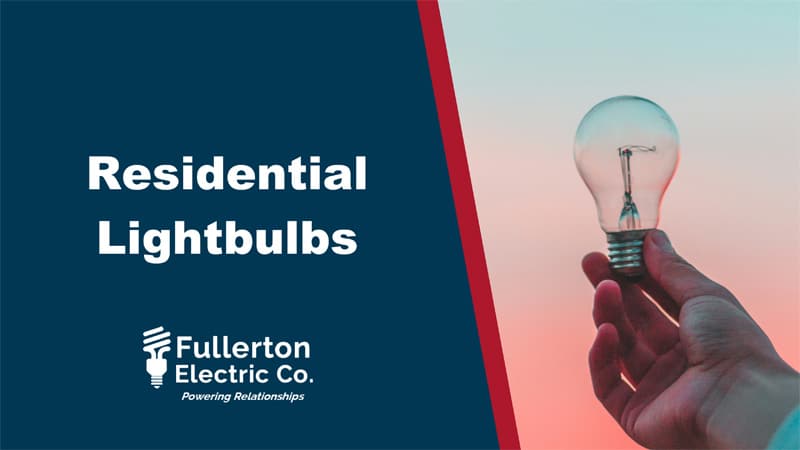Share
Everything You Need to Know About Residential Lightbulbs:
Fullerton Electric Co wants to help you on your next lighting project. We know lighting is important and plays a significant role in influencing mood, productivity, and ambiance. With a so many different lighting options available, understanding the nuances of each type is essential for making informed decisions about lighting your home or workplace. In this comprehensive guide, we will delve into various types of light bulbs, exploring their mechanisms, recommended usage scenarios, as well as their advantages and disadvantages.
Incandescent Bulbs:
How They Work:
Incandescent bulbs have stood the test of time as a traditional lighting option. Operating on the principle of passing electricity through a tungsten filament within a glass bulb, these bulbs emit light as the filament heats up. However, it’s worth noting that a significant portion of the energy consumed is transformed into heat rather than light.
Where to Use:
Incandescent bulbs are known for their warm, soft glow and are best suited for areas where a cozy ambiance is desired, such as living rooms, bedrooms, and dining spaces.
Benefits:
Despite their inefficiency, incandescent bulbs offer a familiar and comforting light quality. Moreover, they are relatively inexpensive to purchase.
Drawbacks:
The biggest drawback of incandescent bulbs is their energy efficiency. A substantial portion of their energy is wasted as heat. Additionally, incandescent bulbs have a relatively short lifespan compared to other lighting options.
Fluorescent Bulbs:
How They Work:
Fluorescent bulbs operate by exciting mercury vapor within a glass tube filled with argon gas. This process produces ultraviolet radiation, which stimulates a phosphor coating on the tube’s interior, resulting in visible light emission.
Where to Use:
Fluorescent bulbs are suitable for illuminating large areas with minimal detail work, and can usually be found in basements, garages, and storage areas.
Benefits:
Fluorescent bulbs are known for their energy efficiency and longevity, making them a popular choice for commercial and industrial settings.
Drawbacks:
Historically associated with cool light color and poor color rendering, fluorescent bulbs may not be suitable for spaces where accurate color representation is critical. Additionally, they are typically incompatible with dimmers.
Compact Fluorescent Lamps (CFLs):
How They Work:
CFLs are a compact version of traditional fluorescent bulbs, offering similar efficiency and longevity. They function based on the same principles as fluorescent bulbs.
Where to Use:
Versatile in application, CFLs can be used in various fixtures in both residential and commercial settings.
Benefits:
CFLs are energy-efficient and long-lasting, available in different sizes and shapes to accommodate different fixture types.
Drawbacks:
Despite their benefits, CFLs may not be compatible with dimmers, and they require proper disposal due to the small amount of mercury they contain.
Light Emitting Diodes (LEDs):
How They Work:
LEDs utilize semiconductor technology to produce light when an electrical current passes through them. Known for their efficiency and durability, LEDs have gained popularity across various lighting applications.
Where to Use:
With a wide variety of color temperatures and wattages LED bulbs can virtually be used anywhere for any of your lighting needs. They use far less electricity than their older counterparts and some have integrated smart features enabling you to control them from your phone.
Benefits:
LEDs offer unparalleled energy efficiency, longevity, durability, and are available in a wide range of colors and styles.
Drawbacks:
While LEDs come with numerous benefits, they typically have a higher initial cost compared to traditional bulbs. Additionally, advancements in LED technology are continuously addressing concerns such as limited light output and color accuracy.
Conclusion:
Selecting the right light bulb involves careful consideration of factors such as energy efficiency, longevity, light quality, and intended use. Each type of bulb has its unique characteristics and applications, allowing for tailored lighting solutions to meet specific needs. As technology advances, the lighting landscape continues to evolve, offering an ever-expanding array of options for creating well-lit and inviting environments. If you want expert advice on what lighting to use in your next project, reach out to Fullerton Electric Co. We are happy to help! Reach out by calling (888) 332-2727 or fill out this form to get connect with us! We look forward to hearing from you!

